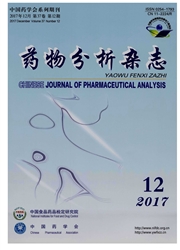

 中文摘要:
中文摘要:
目的:建立冬虫夏草与人工发酵菌丝体的鉴别方法。方法:通过聚合酶链式反应(PCR),扩增基因组上的核糖体基因内转录间隔区(ITS),继而用限制性内切酶XhoⅠ对该聚合酶链式反应产物进行酶切,将酶切产物进行琼脂糖凝胶电泳及紫外成像;通过聚合酶链式反应扩增线粒体细胞色素C氧化酶亚基Ⅰ(COⅠ)的编码基因,将PCR产物进行琼脂糖凝胶电泳及紫外成像。结果:冬虫夏草ITS的PCR产物能够被XhoⅠ酶切成2个片段。而5种人工发酵菌丝体中,有4种不能够被酶切;由于来源于冬虫夏草无性型中华被毛孢,百令胶囊可被酶切且切割条带大小与冬虫夏草组一致。冬虫夏草样品全部扩增得到COⅠ基因(COⅠ)片段,而5种人工发酵菌丝体均未扩增出该片段。结论:结合聚合酶链式反应限制性内切酶片段长度多态性法以及COⅠ聚合酶链式反应扩增,可以鉴别冬虫夏草与人工发酵菌丝体。
 英文摘要:
英文摘要:
Objective: To distinguish Cordyceps sinensis ( C. sinensis) from the cultured mycelia. Methods: The nuclear ribosomal DNA region internal transcribed spacer(ITS) was amplified with polymerase chain reaction(PCR). The PCR products were incubated with the restrictive endonuclease Xho I , followed by agarose gel electrophoresis and image acquiring under UV light. The mitochondria DNA cytochrome c oxidase subunit I ( CO I ) gene was amplified using PCR, followed by electrophoresis and image acquiring. Results:The PCR products amplified from the ITS region of C. sinensis could cleaved into two fragments after incubation with Xho I , while the PCR products from four kinds of cultured mycelia could not. As Bailing capsules were made from the cultured Hirsutella sinensis which were the anamorph of C. sinensis, they showed same results as C. sinensis. In the experiment of CO I amplification, all the samples of C. sinensis consistently showed CO I band, which was not found in Bailing capsules as well as other four kinds of cultured mycelia. Conclusion:A successful identification of C. sinensis from the cultured mycelia could be achieved by the combined application of PCR-RFLP and CO I amplification.
 同期刊论文项目
同期刊论文项目
 同项目期刊论文
同项目期刊论文
 期刊信息
期刊信息
